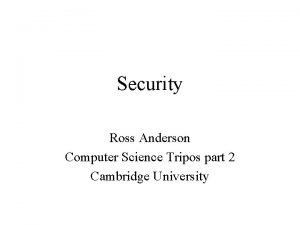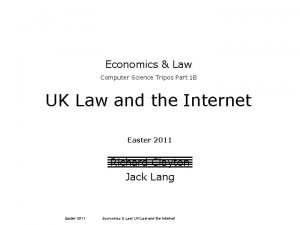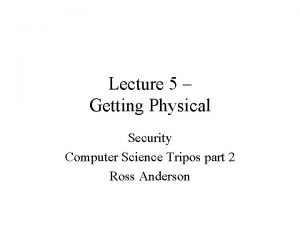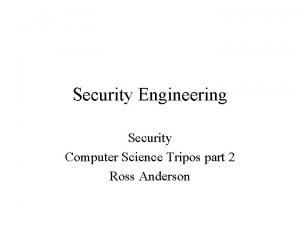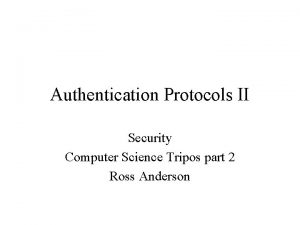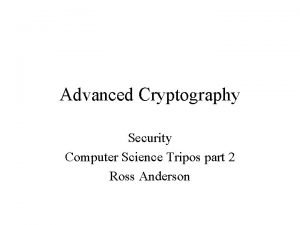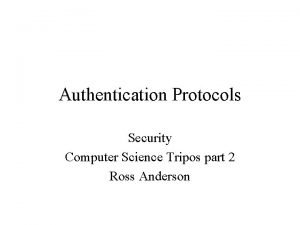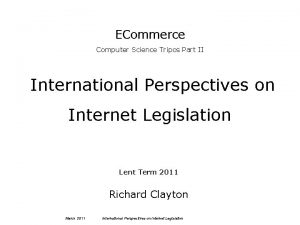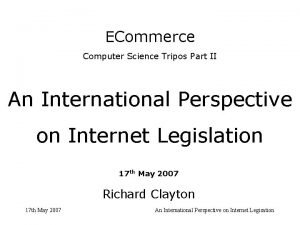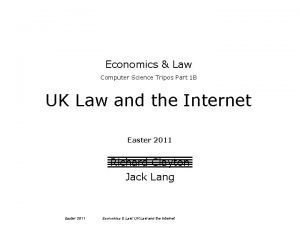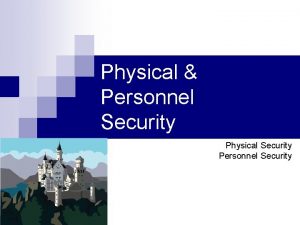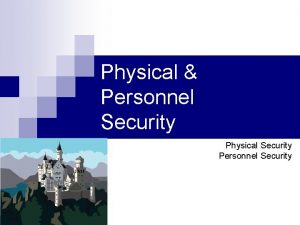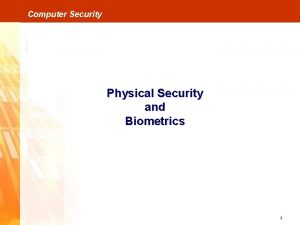Lecture 5 Getting Physical Security Computer Science Tripos

















- Slides: 17

Lecture 5 – Getting Physical Security Computer Science Tripos part 2 Ross Anderson

Availability Policies • Until recently, researchers ignored availability, but it’s where the money goes confidentiality research industry 90% 1% integrity/authenticity 9% 9% availability 90% 1% • Good example: alarms!

The Physical Security Revolution • IT security is rooted in the physical variety (for server rooms, crypto boxes etc) • Old model: firms like Chubb with proprietary fire / burglar alarm systems; locks with master-keying systems • New model: sensors, striker plates, sensors run off ethernet like everything else • We should be able to do better than metal systems • Should be much easier to manage too – but many tensions (manageability, dependability)

Lock Bumping

Lock Bumping (2) • Cut a key down to the (0, 0, 0, 0) bitting • Put it in the keyway, apply torque, and tap • Pins bounce up to shear line and cylinder turns

Lock Bumping (3) • With fancy locks, like sidebar here: break that separately first • pick it, or steal or photograph a key • Enthusiasts have now defeated most mechanical locks

Burglar Alarms • Good example of a service where availability matters! – If there’s a burglar in my vault I want the alarm company to be told! – Not bothered about confidentiality: you can tell other people too – Nor about authenticity: I don’t care who tells them • Wide range of systems: homes – supermarkets – jewelry stores – banks – nuclear facilities • Wide range of standards, from Underwriters’ Labs to the IAEA

How to Steal a Painting (1) • Hollywood idea of art theft: cut through roof, climb down rope, grab painting without stepping on pressure mat (i. e. sensor defeat), get girl… – Response to this perceived threat is more, fancier sensors – There are limits: set by false alarm rates and environmental conditions – Critical science: the Receiver Operating Characteristic (ROC) curve – Multisensor data fusion is really hard! • But most high-grade attacks don’t defeat sensors

How to Steal a Painting (2) • More common type of art theft: hide in broom cupboard, come out at midnight, grab the Rembrandt and head for the fire exit – Understand the service you’re supplying: deter – detect – alarm – delay – response – Don’t rely on tech too much: ‘Titanic effect’ • Or just toss in a smoke grenade. The fire alarm turns off the burglar alarm. Dash in and grab the Rembrandt – If caught, claim you were passing by and dashed in to save the national heritage

How to Steal a Painting (3) • Wait for a dark and stormy night, when false alarms will be common. Create several (fence rattling). Wait till guards stop responding – Typical police force blacklists a property after 3– 4 false alarms – Fix: multiple sensors, e. g. CCTV inside – Problem: we want best sensors on the outside for delay, but on the inside for low false alarm rate • This is the standard way for professionals to do a bank vault!

How to Steal a Painting (4) • • Cut the wire from the sensor to the controller Connect a bogus controller to the phone line Cut the communications to the controller Cut the communications to many controllers – E. g. Holborn explosion – LPC: 2 independent channels for risks over £ 20 m – Armed response force on premises for plutonium • Insurance companies would like resilient anonymous communications to make service denial hard

Alarms – Lessons Learned • Dealing with service denial is becoming more important, and harder • Trade–off between false alarm rate and missed alarm rate is central • You need to be clear what the service you’re supplying (or buying) is – is it about sounding the alarm, or more? • Critically, we need to design the system around the limitations of the human response. E. g. in airport screening, you insert deliberate false alarms. But what more can be said?

Policy Continued … • Bell-La. Padula, Biba and Clark-Wilson are only three early examples of policy • Many industries develop their own, and may get Protection Profiles evaluated • Many things go wrong – people protect the things they can, not the things they should • We often see deception at the policy level! • For now, here’s a useful framework

A Framework Policy Incentives Mechanism Assurance

Policy – a Quick Test • Were the 9/11 hijackings a failure of – incentive, – policy, – mechanism or – assurance? • Since then, tinkering with mechanisms may have been easier than fixing incentives …

Usability and Psychology • ‘Why Johnny Can’t Encrypt’ – study of encryption program PGP – showed that 90% of users couldn’t get it right give 90 minutes • Private / public, encryption / signing keys, plus trust labels was too much – people would delete private keys, or publish them, or whatever • Security is hard – unmotivated users, abstract security policies, lack of feedback … • Much better to have safe defaults (e. g. encrypt and sign everything) • But economics often push the other way …

Usability and Psychology (2) • 1980 s concerns with passwords: technical (crack /etc/passwd, LAN sniffer, retry counter) • 1990 s concerns: weak defaults, attacks at point of entry (vertical ATM keypads), can the user choose a good password and not write it down? • Our 1998 password trial: control group, versus random passwords, versus passphrase • The compliance problem; and can someone who chooses a bad password harm only himself?
 Computer science tripos
Computer science tripos Computer science tripos
Computer science tripos Why johnny can't encrypt
Why johnny can't encrypt Getting ahead
Getting ahead Steroplex
Steroplex Computer security 161 cryptocurrency lecture
Computer security 161 cryptocurrency lecture Physical science lecture notes
Physical science lecture notes Security private
Security private 01:640:244 lecture notes - lecture 15: plat, idah, farad
01:640:244 lecture notes - lecture 15: plat, idah, farad Definition of physical change
Definition of physical change Branches of natural science
Branches of natural science Natural science vs physical science
Natural science vs physical science Nerdy frog
Nerdy frog As a child, which subject of science was your favourite?
As a child, which subject of science was your favourite? Computer-aided drug design lecture notes
Computer-aided drug design lecture notes Computer architecture lecture notes
Computer architecture lecture notes Isa computer architecture
Isa computer architecture Osi security architecture model
Osi security architecture model
